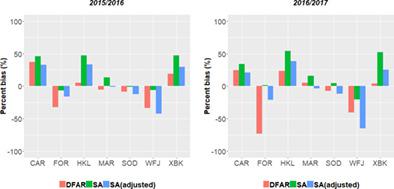当前位置:
X-MOL 学术
›
Atmos. Sci. Lett.
›
论文详情
Our official English website, www.x-mol.net, welcomes your
feedback! (Note: you will need to create a separate account there.)
The potential for uncertainty in Numerical Weather Prediction model verification when using solid precipitation observations
Atmospheric Science Letters ( IF 2.0 ) Pub Date : 2020-04-20 , DOI: 10.1002/asl.976 Samuel T. Buisán 1 , Craig D. Smith 2 , Amber Ross 2 , John Kochendorfer 3 , José Luís Collado 1 , Javier Alastrué 1 , Mareile Wolff 4 , Yves‐Alain Roulet 5 , Michael E. Earle 6 , Timo Laine 7 , Roy Rasmussen 8 , Rodica Nitu 9
Atmospheric Science Letters ( IF 2.0 ) Pub Date : 2020-04-20 , DOI: 10.1002/asl.976 Samuel T. Buisán 1 , Craig D. Smith 2 , Amber Ross 2 , John Kochendorfer 3 , José Luís Collado 1 , Javier Alastrué 1 , Mareile Wolff 4 , Yves‐Alain Roulet 5 , Michael E. Earle 6 , Timo Laine 7 , Roy Rasmussen 8 , Rodica Nitu 9
Affiliation

|
Precipitation forecasts made by Numerical Weather Prediction (NWP) models are typically verified using precipitation gauge observations that are often prone to the wind‐induced undercatch of solid precipitation. Therefore, apparent model biases in solid precipitation forecasts may be due in part to the measurements and not the model. To reduce solid precipitation measurement biases, adjustments in the form of transfer functions were derived within the framework of the World Meteorological Organization Solid Precipitation Inter‐Comparison Experiment (WMO‐SPICE). These transfer functions were applied to single‐Alter shielded gauge measurements at selected SPICE sites during two winter seasons (2015–2016 and 2016–2017). Along with measurements from the WMO automated field reference configuration at each of these SPICE sites, the adjusted and unadjusted gauge observations were used to analyze the bias in a Global NWP model precipitation forecast. The verification of NWP winter precipitation using operational gauges may be subject to verification uncertainty, the magnitude and sign of which varies with the gauge‐shield configuration and the relation between model and site‐specific local climatologies. The application of a transfer function to alter‐shielded gauge measurements increases the amount of solid precipitation reported by the gauge and therefore reduces the NWP precipitation bias at sites where the model tends to overestimate precipitation, and increases the bias at sites where the model underestimates the precipitation. This complicates model verification when only operational (non‐reference) gauge observations are available. Modelers, forecasters, and climatologists must consider this when comparing modeled and observed precipitation.
中文翻译:

使用固体降水观测时数值天气预报模型验证中的不确定性潜力
由数值天气预报(NWP)模型进行的降水预报通常使用降水量计观测值进行验证,而观测值观测值往往容易受到风速导致的固体降水不足。因此,固体降水预报中明显的模型偏差可能部分是由于测量而不是模型造成的。为了减少固体降水的测量偏差,在世界气象组织固体降水比对实验(WMO-SPICE)的框架内对传递函数形式进行了调整。在两个冬季(2015-2016年和2016-2017年),这些传递函数被应用于选定SPICE站点的单变屏蔽测量仪测量。连同来自这些SPICE站点中每个站点的WMO自动现场参考配置的测量结果,调整后和未调整后的观测资料被用来分析全球NWP模型降水预报中的偏差。使用操作仪表对NWP冬季降水进行验证可能会受到验证不确定性的影响,不确定性的大小和符号会随仪表护罩配置以及模型与特定地点的局部气候之间的关系而变化。将传递函数应用于屏蔽测量仪的测量结果会增加测量仪报告的固体降水量,因此会减少模型倾向于高估降水量的地点的NWP降水偏差,并会增加模型低估降水量的地点的偏差。沉淀。当仅可使用(非参考)量规观测值时,这会使模型验证复杂化。建模者,预测者,
更新日期:2020-04-20
中文翻译:

使用固体降水观测时数值天气预报模型验证中的不确定性潜力
由数值天气预报(NWP)模型进行的降水预报通常使用降水量计观测值进行验证,而观测值观测值往往容易受到风速导致的固体降水不足。因此,固体降水预报中明显的模型偏差可能部分是由于测量而不是模型造成的。为了减少固体降水的测量偏差,在世界气象组织固体降水比对实验(WMO-SPICE)的框架内对传递函数形式进行了调整。在两个冬季(2015-2016年和2016-2017年),这些传递函数被应用于选定SPICE站点的单变屏蔽测量仪测量。连同来自这些SPICE站点中每个站点的WMO自动现场参考配置的测量结果,调整后和未调整后的观测资料被用来分析全球NWP模型降水预报中的偏差。使用操作仪表对NWP冬季降水进行验证可能会受到验证不确定性的影响,不确定性的大小和符号会随仪表护罩配置以及模型与特定地点的局部气候之间的关系而变化。将传递函数应用于屏蔽测量仪的测量结果会增加测量仪报告的固体降水量,因此会减少模型倾向于高估降水量的地点的NWP降水偏差,并会增加模型低估降水量的地点的偏差。沉淀。当仅可使用(非参考)量规观测值时,这会使模型验证复杂化。建模者,预测者,









































 京公网安备 11010802027423号
京公网安备 11010802027423号